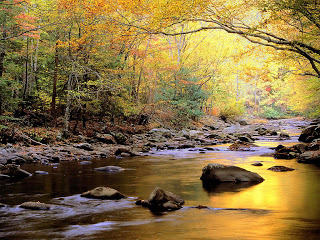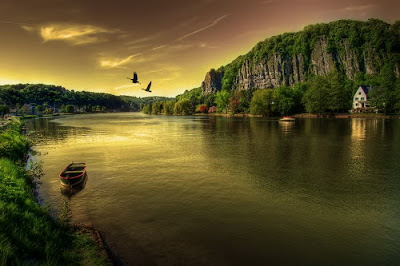INTRODUCTION
A river is a natural watercourse, usually freshwater,
flowing towards an ocean, a lake, a sea, or another river. In a few cases, a
river simply flows into the ground or dries up completely at the end of its
course, and does not reach another body of water. Small rivers may be called by
several other names, including stream, creek, brook, rivulet, and rill. There
are no official definitions for generic terms, such as river, as applied to
geographic features, although in some countries or communities a stream may be
defined by its size. Many names for small rivers are specific to geographic
location; examples are "run" in the United
States , "burn" in Scotland
and northeast England , and
"beck" in northern England .
Sometimes a river is defined as being larger than a creek, but not always: the
language is vague. Rivers are part of the hydrological cycle. Water generally
collects in a river from precipitation through a
Rivers are part of the hydrological cycle. Water generally
collects in a river from precipitation through a
No extraterrestrial rivers are currently known, though large
flows of hydrocarbons described as rivers have recently been found on Titan.
Channels may indicate past rivers on other planets, specifically outflow
channels on Mars and are theorised to exist on planets and moons in habitable
zones of stars.
Types of river in India
Inland drainage basin: This type of rivers found in Rajasthân. Usually, these rivers of
1. Perilium
River
A river that flows continuously throughout the year is a
perennial river.The rivers having their source in the Himalayas viz, Ganga
Indus, Brahmaputra are perennials.
2. Seasonal River:- A
river in arid areas (deserts and other very dry areas) that have water flowing
in them only in the rainy season.
a seasonal river with its headwaters in the Vryburg area,
also joins it. The river is characterised by highly intermittent runoff, but is
regulated to optimise water usage. At Taung the Tswana referred to the Harts River
Importance of River in India
River is the alley of transportation and communication which
is very important especially during the Neolithic Time in Malaysia .
Mankind which survive around the corner had made the position nearby river as
their homes because food resources and water resources can be found easily.
There were still human beings lived in the cave to protect themselves from
enemies and wild animals. A cave will exist through the broken of rocks at
mountains and next to be a hole. It is maybe not much difference for them
because mountains are lik
e a water tanker that gives water sources.
Due to the effect of
technology development, human had changed the surroundings of river to tourism
center, hidroelectric generator, mineral quarried, and others. This may varied
the functions of
river and progress mankind's level undirectly. Outcome of tourism at river and
nearby it has established new oppurtunities of occupation besides given
advantages to kingdom by getting exchanges of foreign notes when foreign
tourists visiting our country.
Apart from these, the
useful of hidroelectric generator enables to keep clean water sources to be
used by Malaysians especially when the progress of occupants getting more
obvious rather than having electric energy. Malaysia
is predicted to has owned for about 60 dams for examples are Timah-Tasoh's dam
in Perlis, Temenggor's dam in Perak, Batang Ai's dam in Sarawak, and Klang
Gates' dam in Kuala Lumpur .
Due to the discovery
of Mother Nature, many mineral sources be found. Tin ore has became main
mineral sources that attract colonialist such as British to conquer the Malay's
land, due to the Revolution Industry happening at their country, made tin ore has
a high require. It is also no bad with gold because this mineral can easily
melted and shaped that made it very expensive besides have a great celebration
especially among women.
Apart from Malaysia , there are also countries that very
required river such as Thailand
and Canada .
Thailand also reknown as 'Venice of East' due to have many canals for examples
Me Wang, Me Nam, Me Ping, Me Yom and Menom Chao Phraya as long as 1290 km.
Menom Chao Phraya in Bangkok becomes main river because many facilities built
there such as transportation for visitors, floating things, alley to carrying
wooden trees to factories and drifting markets which attract visitors. They
also have some hidroelectric generators such as Bhumibol's dam, Sirikat's dam
and Phitsanulok's dam.
While Canada
which located at the west of world, has the longest lake in the world with a
distance as long 3760 kilometer. Water alley of St. Lawrence's big lake
connecting to St. Lawrence's river with Ontario 's
lake to Erie 's lake, Haron's lake, Michigan 's lake and Superior 's
lake. Methods of transportation on water are carrying large quantity of things,
connecting the Atlantic Ocean with large land, and the progress of of cities in
Quebec , Montreal ,
Halifax , and St. John , hidroelectric generator, industrial
sector and water sources. Unfortunately the alley around big lakes only
functioning on May to November but this problem can be overcame by building
canals and doors such as Welland 's
canal.
As conclusion, river
is can gives us many benefits to human that must be taken care of to ensure the
advantages can continued by many generations in the future.
Uses of River :-
 Rivers have been used as a source of water, for obtaining
food, for transport, as a defensive measure, as a source of hydropower to drive
machinery, for bathing, and as a means of disposing of waste.
Rivers have been used as a source of water, for obtaining
food, for transport, as a defensive measure, as a source of hydropower to drive
machinery, for bathing, and as a means of disposing of waste.
Rivers have been used for navigation for thousands of years.
The earliest evidence of navigation is found in the Indus Valley Civilization,
which existed in northwestern Pakistan
around 3300 BC. Riverine navigation provides a cheap means of transport, and is
still used extensively on most major rivers of the world like the Amazon, the
Ganges, the Nile, the Mississippi , and the Indus. Since river boats are often not regulated, they
contribute a large amount to global greenhouse gas emissions, and to local
cancer due to inhaling of particulates emitted by the transports.
In some heavily forested regions such as Scandinavia and Canada ,
lumberjacks use the river to float felled trees downstream to lumber camps for
further processing, saving much effort and cost
by transporting the huge heavy
logs by natural means.
Rivers have been a source of food since pre-history. They can provide a rich source of fish and other edible aquatic life, and are a
major source of fresh water, which can be used for drinking and irrigation. It
is therefore no surprise to find most of the major cities of the world situated
on the banks of rivers. Rivers help to determine the urban form of cities and
neighbourhoods and their corridors often present opportunities for urban
renewal through the development of foreshoreways such as riverwalks. Rivers
also provide an easy means of disposing of waste-water and, in much of the less
developed world, other wastes.


